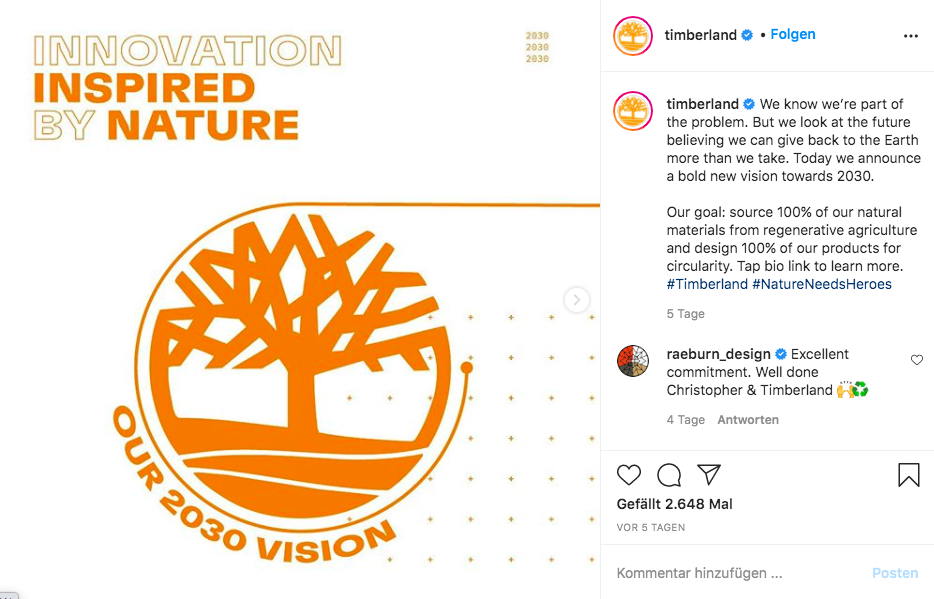“Timberland to be 100% circular and net positive by 2030”
It’s not the first time, fashion brand Timberland is leaping forward to set new industry standards but this time, it sounds like the brand is about to engage in an absolute feat.
It’s the first time Timberland addresses its overall environmental impact and now announced its products to be 100% circular and net positive by 2030. “Leave Nature better than we find it” is the guiding vision for the brand that wants to rethink production within a decade.
How will the brand do it? Is Timberland greenwashing or rather setting a new, urgent precedent for a dirty industry? How much is communication, how much action?
BRAND ACTIVITY
On September 1st, Timberland announced its two sustainability goals for 2030:
In more detail, the two goals encompass:
“1. 100% of our natural materials will come from sources using regenerative agriculture practices. We're already working with regenerative leather, rubber, cotton, wool, and sugarcane farmers.
2. 100% of our products will be designed for circularity. That way they won't have a negative impact, and ultimately achieve zero waste.”
Colleen Vien, director of sustainability for Timberland, commented: “The environment today is in a degraded state. As a footwear and apparel brand, we are part of the problem. For decades Timberland has worked to minimize our impact, but it’s time to do better than that. Imagine a boot that puts more carbon back into the land than was emitted during production. By following nature’s lead, and focusing on circular design and regenerative agriculture, we aim to tip the scales to have a net positive impact - to go beyond sustainability and help nature thrive. We are incredibly excited about this journey, and hope to inspire the industry as a whole to work together and change the trajectory of our collective future.” [1]
THE CLOSE-UP
In the past, Timberland has been successful putting ambitious goals around their environmental footprint front and center. One important milestone was co-founding the Leather Working Group in 2005 to improve the sourcing and production of leather in the fashion industry. Ever since the organization helped leather suppliers and tanneries worldwide to adopt best practices and commit to better standards.
But setting goals doesn’t mean those goals will be achieved. Looking at press releases from a few years ago and comparing publicly communicated goals with their most recent CSR reporting of 2020, the brand also shows how hard it can be to fulfill those goals.
For example, two years ago, Timberland has stated to pursue several sustainability-related goals by 2020 such as using 100% responsible cotton (either organic, BCI certified or US origin cotton), phasing out PVC or reducing the average use of volatile organic compounds (VOCs can create human and environmental health hazards) to 42g per pair.
Although we’re not yet at the end of 2020, Timberland’s second quarter 2020 CSR Report [2] suggests that these goals are not an easy fetch:
The use of VOCs averaged at 45.5g per pair so far in 2020 (compared to 51g in 2019). This implies that, for the rest of the year, Timberlands needs to make up ground for the rest of the year and achieve numbers way below its goal of 42g per pair in order to average at 42g.
Regarding PVC-free footwear, Timberland does not disclose how far they are on track phasing out 100% by 2020. The most recent number from 2019 stated that 97% of its footwear production did not contain PVC. It is striking though that this is the same percentage for 2018 and 2017, meaning there was no improvement for three years in a row. Even more striking are the numbers of the time before. From 2014 to 2016, 98% of the footwear did not contain PVC, meaning the brand’s performance actually decreased over time.
The case for cotton seems even tougher. While it is the goal to source 100% responsible cotton, Timberland’s current status of the second quarter is 59%. The chart, covering data from the past four years, also shows how volatile the numbers are. Between the two preceding quarters the difference between 41% and 77% is very high and obviously doesn’t allow for a reliable forecast.
The report is lacking an explanation why the numbers are so volatile and what the brand will do to ensure the 100% goal.
These examples show that while it is easy to set and communicate goals, it poses a real challenge to fulfilling them. And all of the above mentioned criteria are important to the overall pledge of becoming 100% circular and net positive by 2030.
At this point, I’d like to ask: is it a good practice to communicate new, audacious goals before the “old goals” are not yet achieved?
Timberland does a good job in transparency and engaging in action that not only helps the company gain competitive advantage but the whole industry to adopt environmental best practices. I also appreciate their quarterly CSR Report which is more transparent and reader-friendly than many other reports I’ve read. It explains the metrics it applies, why they are important and what the goal is.
But there’s also room for improvement. Explaining the underlying strategy to achieving the goals and giving insight not only into the numbers but into the story they tell would be a great next step to transparency.
CONCLUSION
In summary, the new 2030 goals are ambitious yet reflect the urgency of the environmental crisis. And based on the past experiences, we have reason to believe Timberland will implement measures to get there. But I do wish to see and understand better the action steps that are related to them as well as the challenges on the path to achievement.
I am not saying Timberland is greenwashing. Their brand history is on their side. But this case study shows that simply setting goals does not translate into a self-fulfilling prophecy. Here’s why accountability is another key to sustainability. Because it’s okay to not achieve goals. As long as we understand why and what to do better next time.
Again, 2020 is not yet over. If Timberland publishes the 2020 CSR Report, it hopefully includes a comprehensive review of the goals it has set itself in the past.
By the way, this case made me think about the general practice of companies communicating sustainability efforts. How come the news is full of companies’ sustainability pledges but bare of celebrating achievements for goals set in the past?
COLORWASHING SCORE
4/10
















After three months of deep-diving into the practice of colorwashing, Karry sums up her insights and gives an outlook on this column moving forward. This is her colorwashing CHECK-OUT. READ MORE